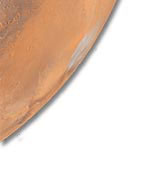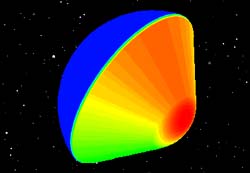
Mars Microprobe 6 Degree-Of-Freedom
Trajectory Simulation
(quicktime movie 38.5MB... that's really big)
(quicktime movie 2.1MB... a little smaller)
Significant design challenges faced the team working on the Aeroshell System as
they aimed for a design which is both simple and cost effective.
Unlike other traditional entry systems like parachutes or rockets, the probes don't separate
from their aeroshells. Instead, the aeroshells are carried to the surface where they shatter on impact.
The DS2 project is the first to apply a single-stage strategy (from atmospheric entry until impact).
This means there are no deployables, parachutes, or airbags to assist in the entry and landing.
Will the probe land like a cat - always on its feet? Yes - the entry system is designed
to passively orient itself upon atmospheric entry prior to peak atmospheric heating. Thus, the
probes are not required to be spin stabilized on release, nor do they need an active attitude
guidance and control system (e.g., thrusters or rockets).
Like a javelin, the probe needs to hit the surface at an appropriate angle or
it may never penetrate. So another design challenge for the NASA engineers was to
ensure the probe would be properly oriented on impact. This is especially difficult
to achieve in the Martian environment, because the probes impact in the transonic
flight regime (which is inherently unstable, causing objects to oscillate).
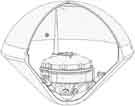
The microprobes are nestled in the nose of the aeroshell to ensure the system's center-of-mass is lower
than its center-of-gravity. This helps to ensure the probes always land "right side up", similar to a badminton birdie.
|
Aeroshell/Entry System
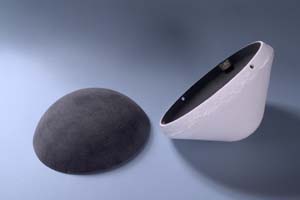
Flight Aftshell and Heatshield Ready for Final Assembly.
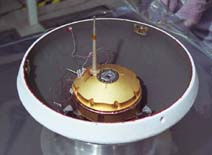
Flight 1 Probe is Installed into the Heatshield.
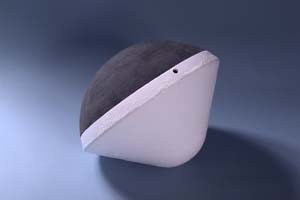
Flight 1 Aeroshell Fully Assembled.
Description
- Completely passive entry (no rockets for active control)
- Single-stage to penetration (no parachutes, airbags, separations)
- Extremely light weight (weighs less than 1.2 kg, or 2.6 lbs)
- Brittle silicon carbide aeroshell structure (same material used to make sandpaper) which shatters on impact
- Advanced heatshield material called SIRCA-SPLIT (Silicon-Impregnated Reusable Ceramic Ablator - Secondary Polymer Layer-Impregnated Technique) which is capable of withstanding surface temperatures up to 2000° C (3,632° F) while maintaining the probes internal temperature to within a few degrees of -40 C (-40 F).
Why is it exciting?
- Mass savings of 50% or more over conventional thermal protection system technologies
- Tolerant entry conditions simplify deployment
- Non-erosive material simplifies aerothermal and aerodynamic analysis
Who needs it?
- Future penetrator missions
- Any low-cost, passive entry into any planetary atmosphere
Developers/Suppliers
|
[
Home |
News |
Mission |
Technology |
Science |
Kid's |
Pictures |
Facts |
Sitemap ]
This page last updated: November 24, 1999
For comments and suggestions, or to request
additional information
please contact:
| Deep Space 2 Outreach and Education |
| Jet Propulsion Laboratory |
| 4800 Oak Grove Avenue |
| M/S 301-235 |
| Pasadena, CA 91109 |
|
  |
| |
|

